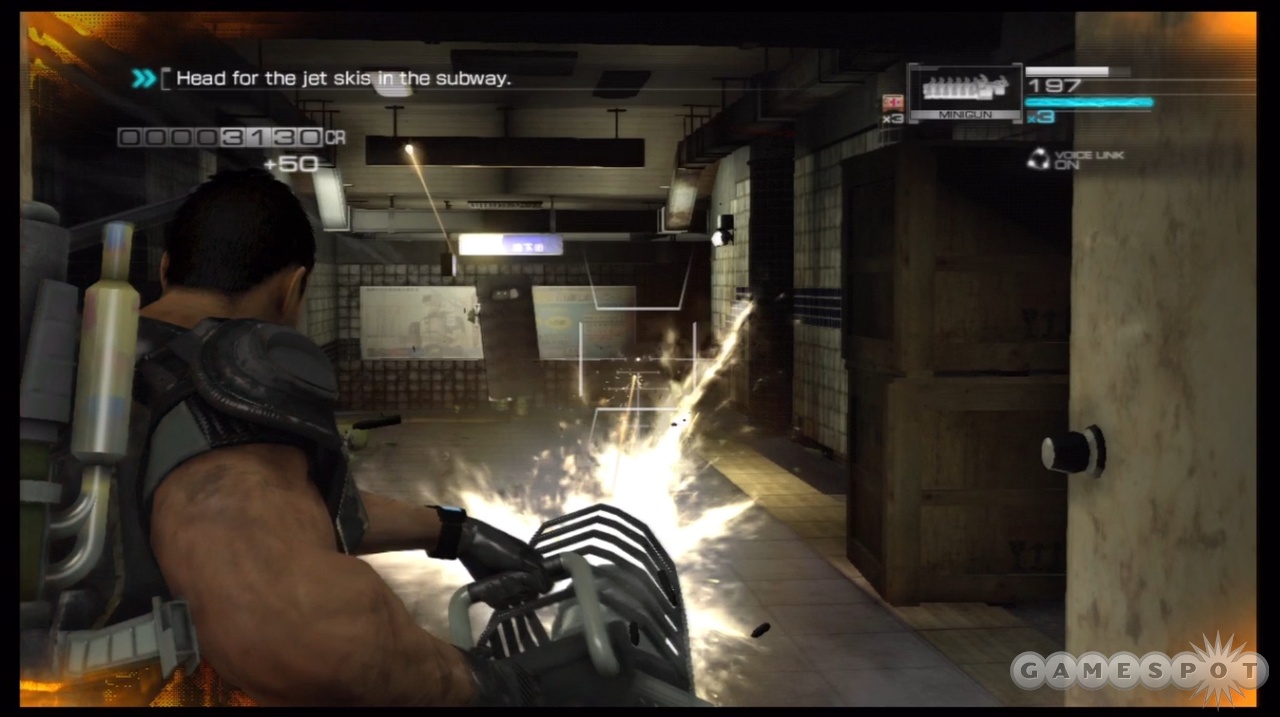What if you lived in a world where robots were as prevalent as humans? You'd see them every day--in the street, at your workplace, in the coffee shop--made to mimic the human figure but easily identifiable as machines. But what if the gap narrowed to the point where human and humanlike robot were indistinguishable to the naked eye? The soldiers in Binary Domain have dedicated themselves to preventing such a world. It's a familiar futuristic trope, and much about this third-person cover-based shooter is familiar. But if you probe past the humdrum fundamentals, Binary Domain reveals some intriguing elements that boost its appeal beyond the ordinary.
The first of these rewards lies in the shooting mechanics. The key is not so much what guns you are shooting (a basic military arsenal with scant futuristic touches) but, rather, whom you are shooting. Your enemies are robotic, most of them humanoid, and they break apart in such a marvelous variety of ways that you won't soon tire of fighting them. Armor plates burst off in showers of sparks, and explosions send enemies rag-dolling, but the real treat is what they do when injured. They limp. They hop. They crawl. They doggedly pursue you until you deliver the killing blow, and the realistic animations are a treat even after you've downed hundreds of foes.
Just as these enemies liven up the standard gunplay, the clever designs also liven up the many drab corridors and bland rooms you encounter in the campaign. You spend a lot of time popping in and out of cover, as well as moving through conventional futuristic-looking environments, but if you take a moment to look around, there are some cool things to see. A massive agricultural complex doesn't just look cool and evoke the human goo farms of The Matrix, but it also resonates strongly with the struggles this society faces and the solutions it has devised.
On the other end of the size spectrum, hand dryers that look like jet turbines offer a glimpse at what the Dysons of the future might engineer. The eye-catching elements aren't everywhere you look, not by a long shot, but these environmental highlights are what you'll remember when the campaign ends. (Oh, and the Tully's Coffee shop, which is the most incongruous and unexpected product placement to come along in a great while.)

When you're in the field, you are frequently given the choice of which characters you want by your side, though this decision has more to do with personality than combat efficacy. You do the heavy lifting when it comes to robot killing, though your teammates aren't useless. They down some foes and can revive you when you're incapacitated, and they rarely devolve into being a liability. You can give them (and yourself) a boost by spending the credits you earn for robo slaughter at the plentiful vending machines. There are basic weapon upgrades, as well as a neat little nano-enhancement system that lets you try to maximize attribute boosts by arranging upgrade pieces of varying sizes on a small grid. It's not a huge asset, but it's a nice injection of variety and progression.
Though these upgrades don't have a big impact on your teammates, there is a way to motivate them. Contextual commands are easily accessed from a quick menu, but if you plug in a microphone, you can use upward of 70 voice phrases to communicate with your AI allies. Tactical orders (retreat, charge), positive reinforcement (awesome, nice work), chastising remarks (idiot, you fool), personal admissions (I like you, lookin' pretty sweet), and vulgar curses (choice four-letter words) are all included in Binary Domain's sizable lexicon. The voice recognition can be unreliable, and dealing with ambient noise and third-party hardware can present issues, but it's never crucial to survival, so these issues are merely frustrating rather than downright aggravating.

When the campaign comes to a climax and concludes (somewhere in the nine-hour ballpark), you'll be happy you saw it through, but get ready to temper that enthusiasm if you hop online for multiplayer. The cooperative Invasion mode has plenty of robot killing for up to four players, but the repetitive environments and bland soldiers aren't much encouragement for soldiering on through 50 waves of enemies. The competitive multiplayer has a basic suite of modes for up to 10 players, with variants that disallow respawning. Though you can get into some good matches, the maps are uninspired and practically encourage spawn camping. Furthermore, both online modes are hampered by lag, which results in visual bugs and connection issues.
So Binary Domain is a bad bet for the multiplayer aficionado, but for those looking for a shooter campaign with a refreshing vibe, it's a very good choice. The variety and destructibility of the enemies, the intriguing and well-paced environments, and the lively and colorful cast all combine to make Binary Domain an enjoyable and energetic success.